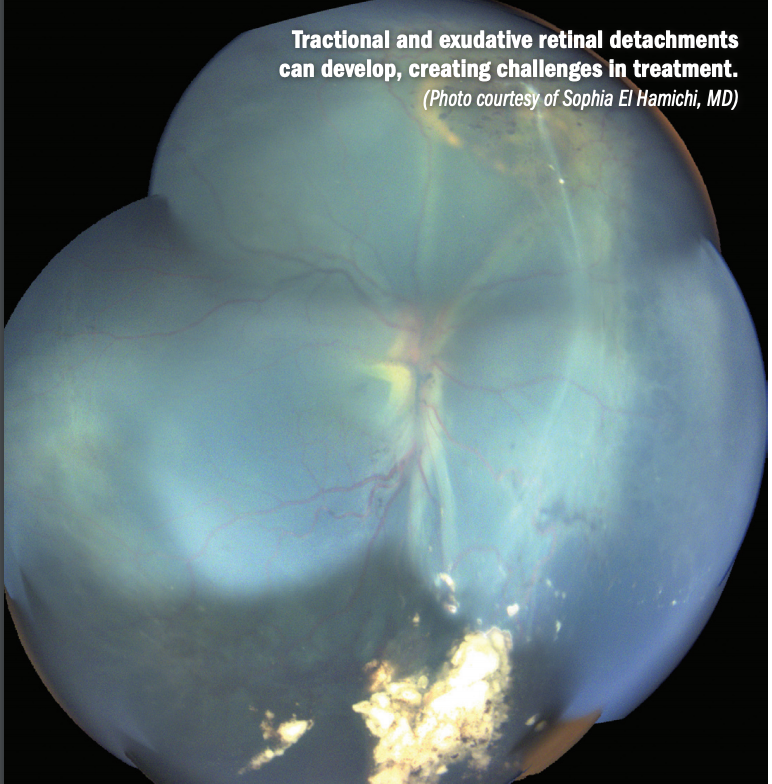Publication
Article
Digital Edition
Persistent retinal detachment connected to retinoblastoma
Author(s):
Watchful waiting may prove to be beneficial in complicated cases


This article was reviewed by Sophia El Hamichi, MD
Retinoblastoma (RB) is the most frequently seen intraocular cancer in children, a complication of which is retinal detachment (RD).
While the main focus of treatment is curing the cancer and preserving the eye, the visual function is important to the patient’s quality of life.
These cases are not without potential hurdles. The RDs can prove to be complex problems that are persistent, and therein lies the challenge to ophthalmologists, according to Sophia El Hamichi, MD, from Murray Ocular Oncology and Retina in Miami, Florida.
Related: Retinal pathologies challenging to image with current technologies
Study
El Hamichi and her colleagues conducted a retrospective study in which they reviewed and described persistent RDs in eyes with RBs, the etiologies, treatment attempts, and outcomes in this patient population between June 2012 and December 2019.
A review of the medical records identified 62 patients with RB during the study period. Persistence of RDs was defined as the presence of subretinal fluid after the patients had been treated for RB and achieved complete tumor regression.
Of these patients, a RD developed in 42 (67%), of which 35 resolved successfully.
The other 7 patients (5 boys, 2 girls) had a persistent RD; in these patients, the RB was bilateral in 3 patients and unilateral in 4.
In all patients, the RB and RD presented simultaneously during the first ophthalmologic assessment. The mean age at diagnosis of RB was 11 months (range, 2 days-24 months).
Related: NR600 retinal prosthesis: Safe with promising visual results
The ages at diagnosis of RD ranged from 2 days to 24 months. All eyes had an advanced stage of RB, ie, state 5B in 8 eyes and stage 4 in 2 eyes.
Intraarterial chemotherapy was applied in 6 eyes of 5 patients and systemic chemotherapy in 3 patients; 1 patient was treated with intraarterial chemotherapy bilaterally and systemic chemotherapy. One patient underwent external beam radiation therapy and a periocular injection of carboplatin. Cryotherapy and intravitreal chemotherapy were not used on any patients.
The RDs were complex in all eyes. In 9 eyes, the detachment had exudative and tractional components. One eye had a pure tractional RD as the result of persistent fetal vasculature. The RDs were not repaired surgically in any eyes, El Hamichi said.
Following treatment, the tumors did not recur in any eyes. The eyes were anatomically stable. One patient had a globe phthisis in 1 eye, and another patient had a globe pre-phthisis; both patients had bilateral RBs and bilateral retinal detachments with poor visual outcomes.
Related: Micropulse laser therapy a safe treatment for retinal disorders
RD types in RB
In RB, exudative, rhegmatogenous, and tractional RDs can develop. The exudative type tends to occur when an exophytic RB is present subretinally and generally is associated with subretinal tumor seeding.
In these cases, when the tumor responses to chemotherapy, the RD was reported to resolve spontaneously.1
Another study found that the first round of chemotherapy caused exudative RDs when eyes did not receive focal consolidation treatment, possibly because of excessive inflammation from chemoreduction or rapid tumor reduction.2
Intra-arterial chemotherapy resolves 43% of total RDs and all partial RDs associated with RB.3 Exudative RDs have developed after intra-arterial chemotherapy that never resolved despite tumor regression.
Rhegmatogenous RDs probably develop as the result of focal retinal necrosis and retinal breaks that resulted from cryotherapy applied to the tumor area. The area around the tumor usually has an exudative RD present.
Related: Harnessing regeneration of retinal tissues: An option almost within reach
Another theory about rhegmatogenous RDs is that focal inflammation increases in response to cryotherapy in eyes with inflammation because of the tumor.
Traction and breaks in weakened retinal zones result. These patients, most of whom undergo chemoreduction, are more susceptible to complications.
Some rhegmatogenous RDs have developed after intraarterial chemotherapy as a result of rapid tumor regression that leaves an atrophic retinal hole. Rhegmatogenous RDs seem to occur mostly in eyes with advanced disease with extensive endophytic tumors.
Related: Intravitreally injected hRPCs improve vision in retinitis pigmentosa cases
RD correction
The caveat in these eyes is that surgery in the presence of active RB carries a high risk of tumor metastasis.
Pars plana vitrectomy can be an option in cases of RD of more than 1 mechanism in an attempt to restore the retinal anatomy and possibly vision.
However, the investigators pointed out that the risk of tumor dissemination outweighs the benefit of repairing the RD.
The investigators recommended that surgery not be performed until 2 years after the patient underwent their last treatment for RB. If the RB is not controlled, enucleation is mandatory.
Based on the study findings, the investigators concluded, “the development of RD can be challenging in cases of RB, especially when it has a complex configuration leading to persistence of the RD. These RDs are difficult to treat, and the visual outcomes can be compromised. Vitrectomy should not be performed until the patient is free of RB for 2 years to avoid spreading the tumor and metastatic disease. This waiting period affects the surgical results and even calls into question its necessity.”
Read more by Lynda Charters
--
Sophia El Hamichi, MD
e:sophiaelhamichi@gmail.com
El Hamichi has no financial interest in this subject matter.
REFERENCES
1. Shields JA, Shields CL. Management of retinoblastoma. In: Shields JA, Shields CL, eds. Intraocular Tumors: An Atlas and Textbook. Lippincott Williams Wilkins; 2008:334-351.
2. Elaraoud I, Ch’ng S, Karl D, Kalogeropoulos D, Chavan R, Sharma A. Management of retinal detachment in retinoblastoma with globe conserving treatment. J Curr Ophthalmol. 2018;31(1):43-48. doi:10.1016/j.joco.2018.09.002
3. Shields CL, Kaliki S, Shah SU, Bianciotto CG, Jabbour P, Shields JA. Effect of intraarterial chemotherapy on retinoblastoma-induced retinal detachment. Retina. 2012;32(4):799-804. doi:10.1097/IAE.0b013e31823d8e1e

Newsletter
Don’t miss out—get Ophthalmology Times updates on the latest clinical advancements and expert interviews, straight to your inbox.




